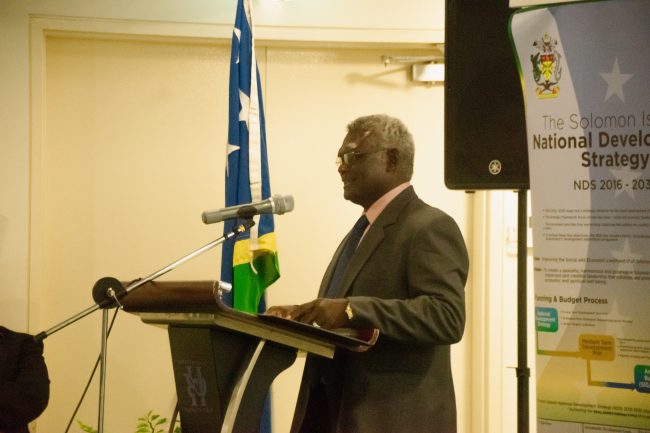COVID-19 Impacts the Implementation of the NDS 2016-2035
The Ministry of National Planning and Development Coordination (MNPDC) will assess the impacts of the COVID-19 pandemic on the Solomon Islands National Development Strategy (NDS) 2016-2035.
Prime Minister of the Solomon Islands, Manasseh Sogavare underlined this issue, during his keynote address at the official launch of the Solomon Islands NDS 2016-2035 Progress Review, yesterday.
“COVID19 drastically changed the development landscape and situation in just a short time and it might be the case that there are reversals in some hard won gains,” Mr Sogavare explained.
He further states that aside from health impacts, COVID-19 also imposed significant economic and social impacts on Solomon Islands as a Least Developed Country (LCD) and Small Island Developing State.

Prime Minister Manasseh Sogavare speaking during the launch of the Solomon Islands NDS 2016-2035 Progress Review
Meanwhile, Permanent Secretary of MNPDC, Susan Sulu spoke on the progress indicators while presenting an overview of the NDS 2016-2035 review process.
“In terms of progress, we are a little bit off target… COVID has really dealt us a significant blow in that regard,” Ms Sulu said.
According to NDS Target projections, GDP growth per annum should have continued at 3.5 percent in 2020 and gradually increase from 5 percent to a sustainable 7 percent between 2025 to 2030.
However, the country’s GDP contracted by 0.5 percent in 2021 and 3.6 percent in 2022, due to the impacts of COVID-19 and the 2021 civil unrest.
Despite the shortfall, the MNPDC projects an annual GDP growth at 2.1 percent over the medium term, and anticipates further progress following the completion of the NDS 2016-2035 review.
Meanwhile, the NDS review consultations begin in Honiara this week.

MNPDC Team (Left) during a consultation with the Ministry of Women, Youth, Children and Family Affairs. Photo: Supplied MNPDC
The consultation team will be deployed to the provinces to hold consultations with elders, community members, communities and all the stakeholders at the provincial government level.
END///
By Andrea Ma’ahanua and Mary Manelegua

